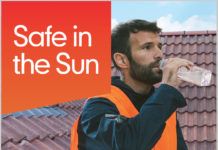
We’ve been campaigning for better safe in the sun practices on construction sites for over a decade now. The warnings about covering up, wearing a 30+ factor sunscreen and taking breaks in the shade are just as important now as they were back then, particularly for roofers who are one of the groups at higher risk of developing skin cancer.
Yet, an equally important concern that does not get as much attention, is the fact that roofers are particularly vulnerable to the impact of heat stress and dehydration – not only because of the PPE that has to be worn but also because of the extreme temperatures they experience. 18°C on the ground can mean 32°C in direct sunlight on a roof and in a heat-wave, roof temperatures could get as high as 60°C.
In very hot, hardworking conditions, experts have found that workers on site can lose up to 1.5 litres of water in sweat every hour, which shows how roofers can very quickly become dangerously dehydrated in the sun. Within just two hours of moderate work in hot conditions, workers may begin to feel the initial stages of heat stress, which can quickly lead on to problems such as fatigue, dizziness and lack of concentration, particularly dangerous when working at height.
Contrary to popular belief, it doesn’t have to be baking hot to put you at risk of heat stress on site either. According to experts, the effects of heat strain start to be felt on the body even at lower temperatures of around 16°C and construction workers wearing hot, protective clothing are particularly susceptible to dehydration.
Replacing body fluids lost during sweating is therefore crucial. Rather than waiting until you get thirsty or have a rest break, drinking at regular intervals throughout the day is the best approach. In fact, the Health and Safety Executive (HSE) recommends when working hard in heat stress conditions, people should consume around 250ml (half a pint) of water every 15 minutes. If you were working hard in hot conditions for five hours, that would add up to five litres in total!
All companies are legally obliged to provide water to their employees working on construction sites. Since April last year, all domestic building and refurbishment projects have to follow the CDM Regulations, which state that a supply of drinking water must be readily available for employees working on site, no matter how small the job. Unless it is a drinking fountain, employers must also provide cups or other drinking vessels at the water supply.
However, this legal obligation to provide a readily available supply of water doesn’t go far enough to prevent dehydration. Employers should introduce hydration guidance as part of their Safe in the Sun policies to make sure site teams know how much they should be drinking and are aware of the signs of dehydration.
In addition to the health and safety considerations, being better hydrated on site should lead to a more productive work force as being just 1% dehydrated has been found to decrease productivity by 12%. The more dehydrated you become, the further your physical work capacity degrades, with 3 to 4% dehydration bringing about a 25-50% decline in performance.
Top tips for staying hydrated
As part of this year’s Safe in the Sun campaign, we have put together some advice to make sure you and your employees stay hydrated in the heat, helping to protect both health and work rates on site:
1. Learn to recognise the signs of dehydration which include; rapid heartbeat, tiredness, dizziness, feeling light-headed, dry mouth, irritability and dark coloured urine.
2. Remember that prevention is better than cure. By the time you are thirsty, you are already 2% dehydrated, making it harder to rehydrate. Hydration experts and the HSE recommend drinking 250 ml (or a cup) of water every 15 to 20 minutes in hot weather to replace the fluids lost through sweat.
If this is not possible, for example if you are driving or operating machinery, the HSE recommends that an acceptable alternative is to drink 500ml of water per hour before work commences and then drinking 500ml water during rest periods.
3. Where it is safe to do so, keep individual containers of cool, clean water within easy reach at all times. For this year’s Safe in the Sun campaign, Marley Eternit is providing free stainless steel water bottles to help provide easy access to water. To order your bottle, please email: info@marleyeternit.co.uk. Marley Eternit will donate £1 to WaterAid for every bottle requested during the Safe in the Sun campaign.
4. Make sure you take rest breaks in shaded areas and take time to drink fluids, as well as eating food to replace essential electrolytes (sodium) that have been lost through sweat.
5. Try to drink water, rather than tea, coffee and fizzy drinks which do not hydrate you effectively. Diluted squash or fruit juices are also good for rehydration but be mindful of sugar content if drinking such large volumes of fluid.
6. Drink cool water, which is absorbed more quickly by the body than warm or very cold fluids.
7. Follow good safe in the sun practices – keep a shirt or jacket on, use sunscreen with an SPF of at least 30 on any exposed skin and reapply regularly. Wear a hard hat at all times, preferably with a brim and flap that will cover the ears and the back of the neck.
8. If you are an employer, introducing and enforcing a hydration policy among your site team is not only important for health and safety but could also significantly boost productivity during the summer months.
For further information about the Safe in the Sun campaign, or to order your free water bottle, visit www.marleyeternit.co.uk/About/Safe-in-the-Sun



